Robert (Bob) Hunter was a notable Canadian environmentalist, journalist, author and politician who gained recognition for his involvement in various environmental causes and his instrumental role in the early days of Greenpeace. He dedicated his life to raising awareness about pressing environmental issues and advocating for their conservation, and his contributions and leadership continue to inspire environmental activists worldwide.
Hunter passed away before his time in May 2005, but his legacy lives on. Kinute sat down with his wife, Bobbi Hunter, to talk about "Mr. Mindbomb," a new chronology of the remarkable events of Hunter’s life, written chapter by chapter by those who knew him.
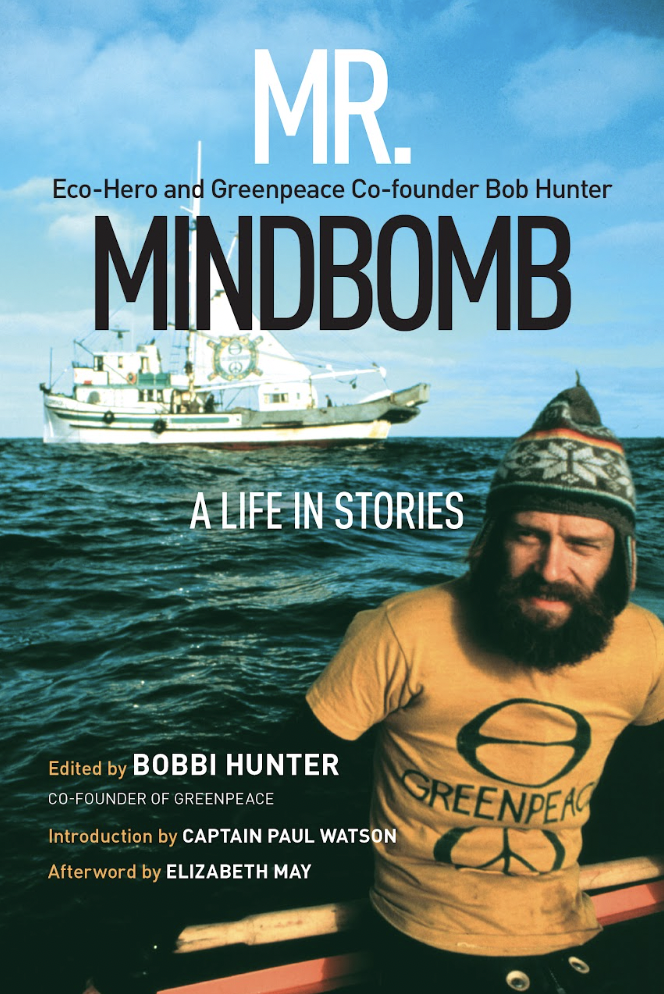
Q: What is a “Mindbomb” as Robert Hunter defined it?
A: A mindbomb is an idea that results in imagery so powerful it galvanizes the attention of the mass media. A transference from a mind thought to an explosion in societal consciousness. At the time that Bob coined the term “mindbomb,” the only media available was TV, newspapers and radio. His target audience was the TV viewer of the 70s. He thought of actions or stunts which would appeal to TV and newspaper editors and once the image was transferred to the viewers or readers eyes, the image would do its work and blow their minds. Bob was aiming for an image that would stay embedded in the mind of the person, such as the image of himself and George Korotva charging in an inflatable craft in front of a harpoon out in the mid Pacific to protect a whale from being killed. While doing this action the harpoon was shot and the image of it sailing over the heads of the two heroic activists was captured on camera and was sent off to the major networks in the U.S. The result of that mindbomb was the true start of the Whale Saving movement. Idea, Action and then Consciousness Change, results in a mindbomb.

Bob Hunter (left) at the helm of the Phyllis Cormack together with Ben Metcalfe. En route to Amchitka, September 1971. © Greenpeace | Robert Keziere
How did Robert Hunter’s concept of a “mindbomb” influence his activism, and in turn how does his life influence modern climate-related activism?
The direct nonviolent activism that Bob engineered through his mindbomb campaigns from stopping nuclear testing, to whale saving, to halting the seal slaughter, took place at the beginning of the environmental activist movement in North America. This kind of action quickly spread to Europe.
As well as an activist, Bob was first of all a journalist. He understood the role the media played, and he played the media. But he also was a prolific writer, and he constantly was feeding the media of that time with his stories, knowledge and words. Bob spent his last years educating the public about the coming crisis of climate change on his media TV programs but he also wrote a book titled “Thermageddon: Countdown to 2030,” published in 2005, which he started to write in the mid 1980s. Global Warming was the greatest threat to mankind and Bob was alarmed about it 40 years ago.
For him the highlight was to create an effective mindbomb campaign. He was working on some approaches to putting the spotlight on the Global Warming issue, but he died before he was able to affect them. His tried and tested approach to activism, the planting of mind bombs, is still in practice today in Europe with the sit-ins, demonstrations and hijinks of the Extinction Rebellion movement that has its focus on climate inaction. Bob would be moved to know that they are taking up the cause.

The founding of Greenpeace International. Portrait of Bob Hunter, June 1979. © Greenpeace | Rex Weyler
You were Robert Hunter’s wife and partner in activism. Can you talk about that balance and that relationship a bit?
Bob and I were a team, a power couple. We were opposites of a highly compatible variety. I was the foundation on which he was able to stand and be seen. I was a facilitator for his brilliant ideas. He was the people power person who could get disconnected entities to work together for a greater good. He was brilliant, charismatic and focused on saving the planet. I was the person behind the scenes who gave him the freedom to do his magic. I opened the first and second offices, incorporated the name of Greenpeace, was the treasurer, fundraiser and eventually first woman in front of a harpoon to save a whale. But my real mission was to assist Bob in his noble cause. We had a great pure love for each other, but Bob and I could fight at times with great conviction, it was not personal. We were always equals working for solutions. Through all that we experienced so much joy, it is hard to describe it.
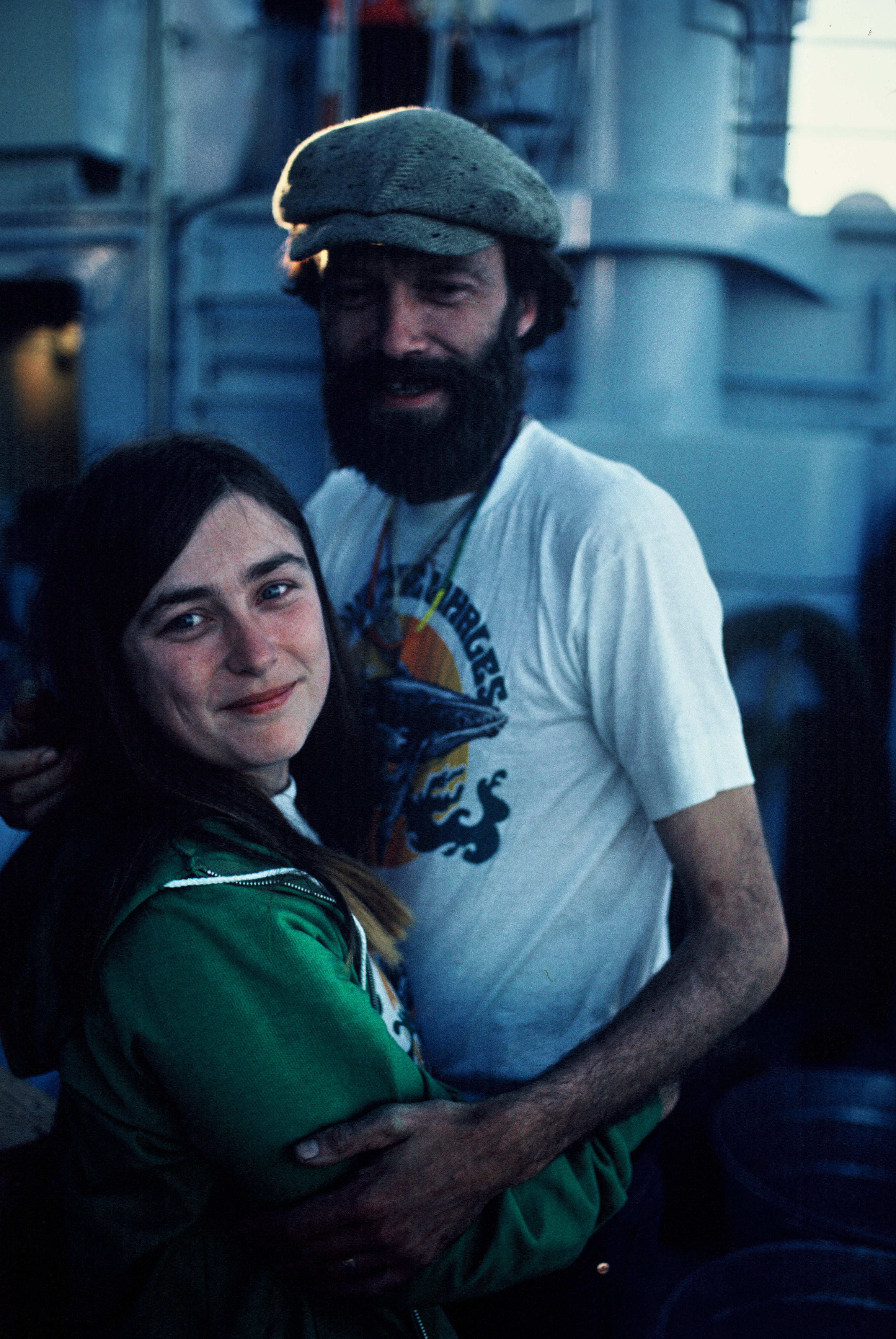
Bob and Bobbi Hunter on board the James Bay during the June 1976 whale campaign. © Greenpeace / Rex Weyler
You led the creation of this “biography-in-essays” which collects contributions from many leaders and figures who knew Bob during his life. Can you talk a bit about that process?
At the start of COVID when we were all locked away in our homes, our family connected through Zoom chats. We all decided to start projects and talk about them. I took on the challenge of getting one of Bob's unpublished novels published. One year after declaring I was going to do that, his beautiful novel, “Long Way to the Horizon,” was published. I enjoyed the process of getting a book to print so much, I decided to carry on and get a book out about Bob’s life. There is no other book devoted to Bob. I realized that I was not the only person with stories to tell about Bob, but I was the only one who knew his full story. So, I put out a feeler to about 20 friends, cohorts and relatives to see if they wanted to be a part of this book. One of the first to say yes was our lifelong friend Paul Watson, an original co-founder of Greenpeace, founder of Sea Shepherd Society and now the founder of the Paul Watson Foundation. Once our incorrigible and lifelong activist friend Paul was on board many others wanted to write in the same book as him. The writers kept appearing and eventually there were 43 writers who wanted to contribute, of which over half are professional writers. We have Elizabeth May the leader of the Green Party of Canada, Rex Weyler a Greenpeace historian, Hap Wilson and Wilderness Guide and Writer and Paul Watson just to name a few. It was a joy for me and for all the writers to go back to those special times with Bob and express all that he had taught us and had meant to us. It took one year to write, one year to find a publisher and another half year to get it to print. It was meant to be.
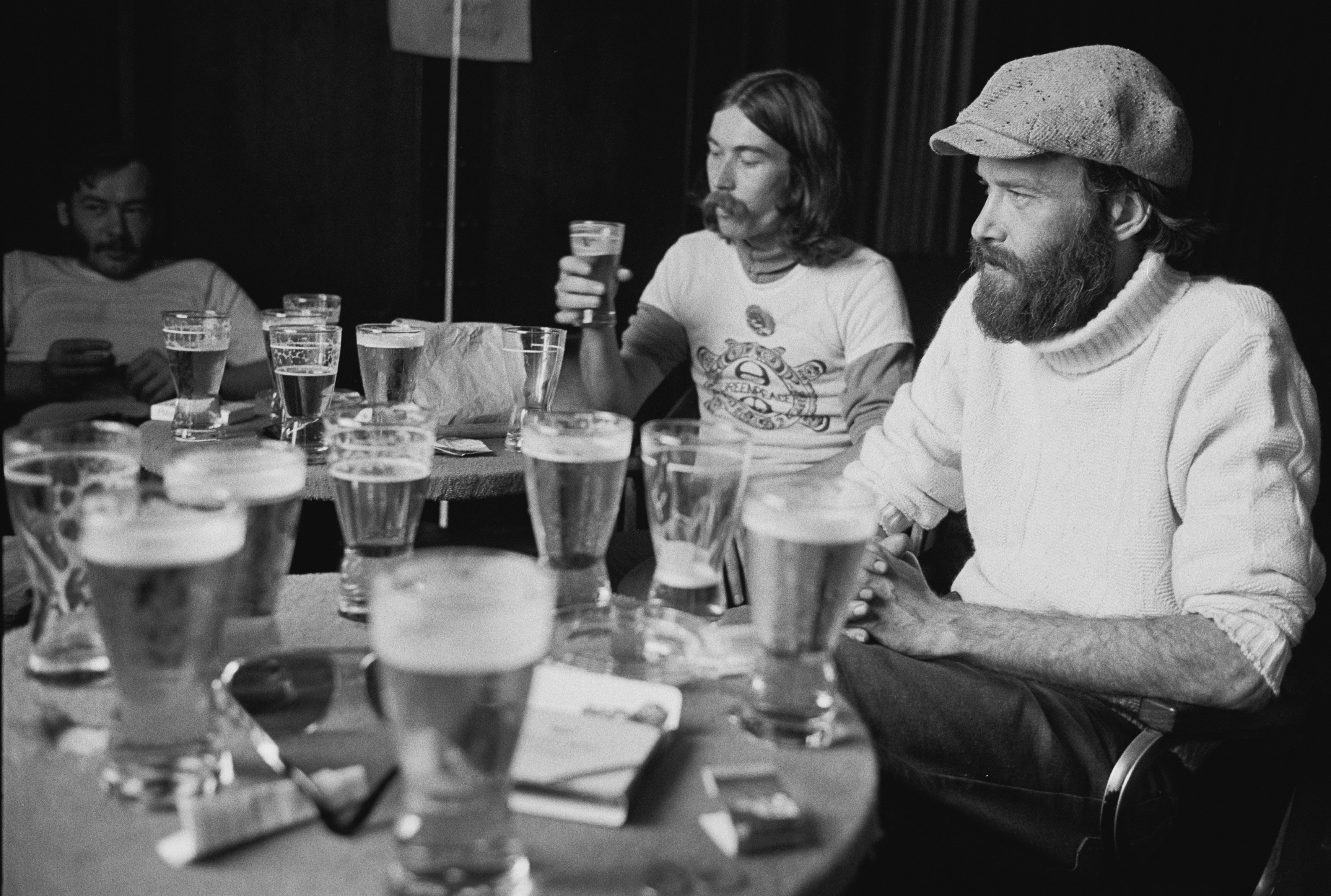
Provided photoBob Hunter with Walrus and other Greenpeace crew in the Tofino pub, June 1976. © Greenpeace | Rex Weyler
What was Bob like outside of his activism and work with Greenpeace?
Bob was a funny funny man. I got all his jokes. We laughed all the time. Life was a joy with Bob. He was also a devoted father to his four children, Justine and Conan from his first wife and Will and Emily who we brought to life. He spent as much time as possible with them. He adored his children and worked to pass on his ideas to them, and as a consequence they are all creative people. He loved to read, he never was without a book to read, every day. He had a huge comic collection and took a lot of ideas from the creative writers of that genre. He was a writer of 14 books, and he won several prestigious writing awards. He also wrote many magazine articles and thousands of columns in newspapers. Musically he had a tin ear, but he loved the music of the 40s to the 70s. He would often twist the lyrics to make a great side-splitting joke out of them. He also loved to travel. He had travelled to nearly 60 countries by the time he died. We lived in and owned a few boats in our time together. For pleasure we would set out for weekends in our small crafts and just enjoy being on the water. He loved nature and was a seasoned canoeist. He had a lot of friends and he loved to entertain them at home with dinners and laughter. Life with Bob was a constant buzz.
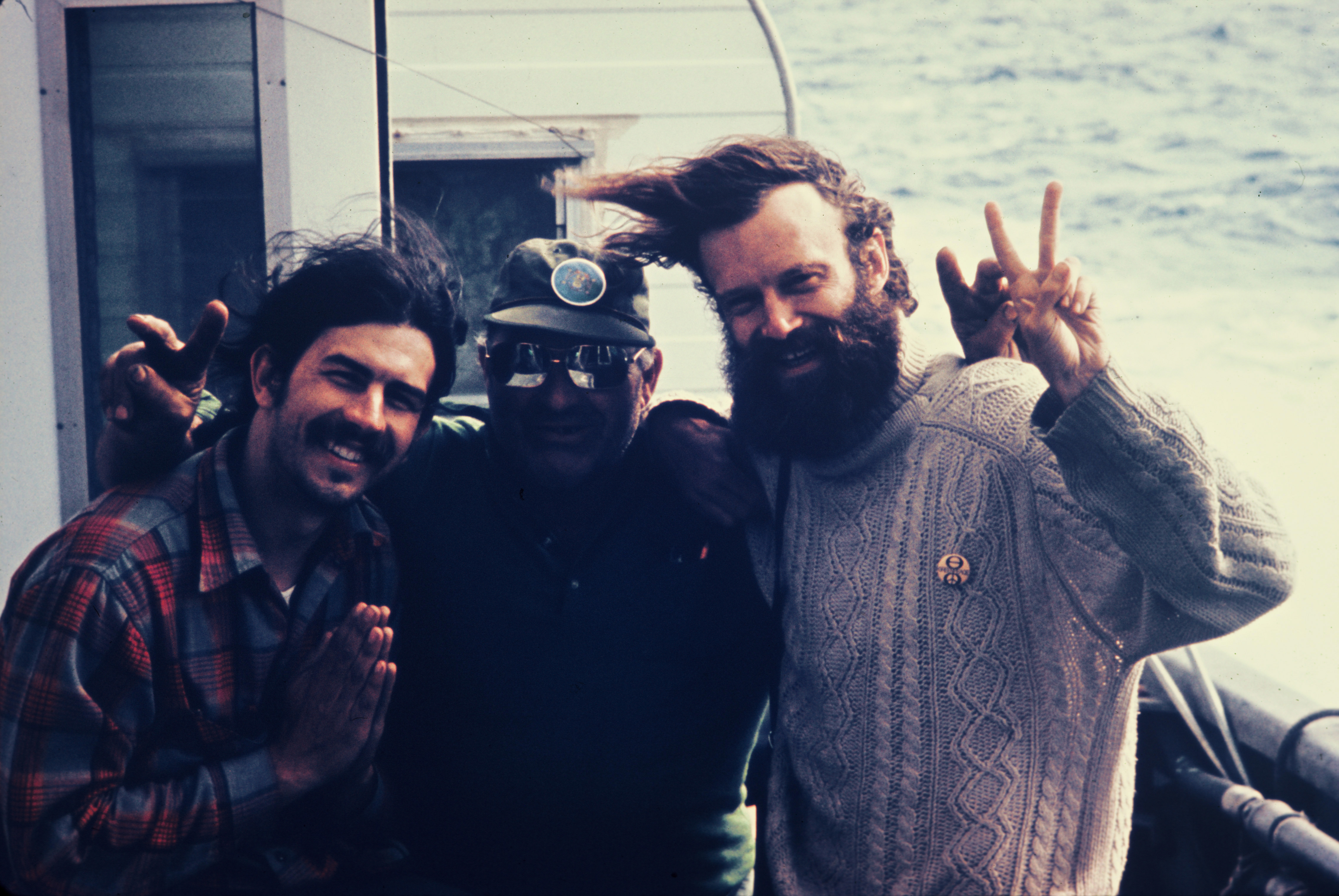
Rex Weyler, John Cormack, and Bob Hunter on board the Phyllis Cormack in the North Pacific in June 1975. © Greenpeace | Ron Precious
Do you consider Bob a “forefather” of the modern environmental/climate activism movement?
Although the term ecology first came to be used by a German zoologist in 1866, it was not commonly used until the mid 1970. Bob was a columnist for the largest daily newspaper in Vancouver in the early 1970. He was reading Paul Ehrlich’s “The Population Bomb” and Barry Commoner's writings about growth, affluence and flawed technology. At this time there was the United Nations Conference on Human Environment and then Three Mile Island happened. Bob wrote columns about the emerging environmental consciousness and catastrophes, and he passed his findings on to eager young ears. He was one important voice in that decade that gave both knowledge and a platform to the up-and-coming wave of environmental activists and activism. So, in that respect, yes, he was a forefather. He was also the glue that helped create and keep Greenpeace together. He was the first president of Greenpeace, and he was able to evolve the organization from a grassroots one issue organization to that of a true international Environmental Force. He also was pushing for action on the climate crisis well before any other environmental leaders. In the mid 1980s, urgency often fell on deaf ears. But his words and works finally did take effect and he would be pleased to see the level of urgency that many groups feel about this issue today.

Paul Spong (left) and Bob Hunter (right) during the Pacific Ocean Russian Whaling Campaign in May 1976. © Greenpeace | Rex Weyler
Can you talk about Robert’s early years and development as an activist/organizer?
Bob started his career as a journalist in his late teens at the Winnipeg Tribune in his hometown. He was influenced by some of the old media masters out of Fleet Street London who had emigrated to Canada and worked alongside him. He loved the media game, and he was a great writer. He moved to Vancouver in the 60s when he got a job as a reporter there. He soon moved up the ranks and he became the youngest reporter at the Vancouver Sun to have his own column. From this column he gave voice to every counterculture group that emerged. He relayed the essence of the movers and thinkers of that era out to his eager readers. He wrote about the feminist movement and the Black Power movement. He also championed some personal favored causes from Mental Patients’ rights, First Nations struggles to the emerging environmental awareness on several issues, top among them at that time was a Ban the Bomb movement. He was like a pied piper, the more he gave focus to groups the more groups succeeded and then the more groups coalesced and emerged.
He first entered Greenpeace as a reporter on the first ship that was sent out to try to put an end to nuclear testing at Amchitka, Alaska. Within a few years he cast away his establishment newspaper job and became the first president and visionary for Greenpeace. The battle to save the planet was on and he was among the leaders lighting the way.
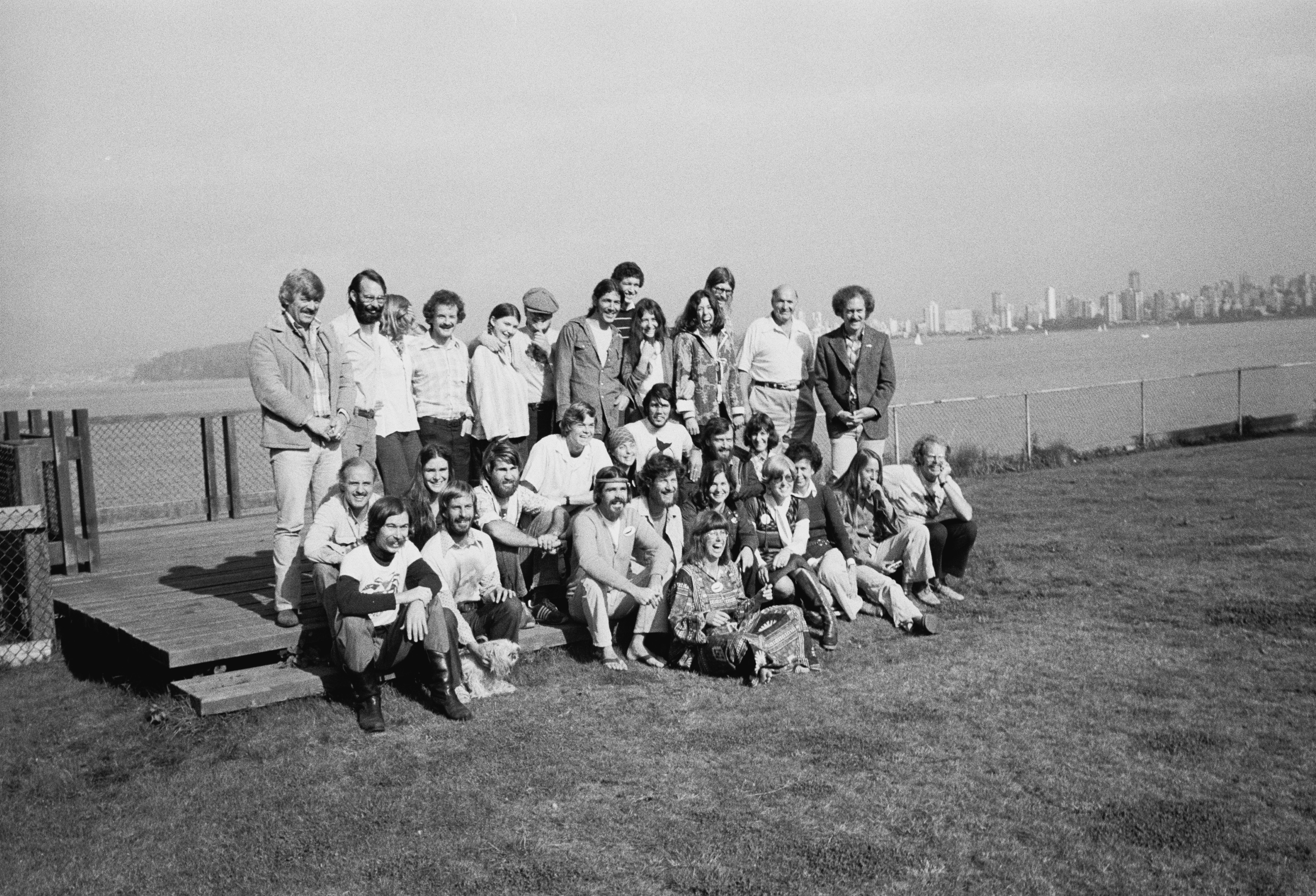
The first global (international) Greenpeace meeting on Oct. 1, 1977; first row from left: David Garrick (Walrus), Hal Ward (CIA), Dexter Cate (US), Rod Marining, unknown, Carlie Trueman, Cindy Baker, Margaret Tillbury, Nancy Jack, Don White; second row, from left: David McTaggart (France), unknown, unknown, Michael Bailey, unknown, Campbell Plowden (US), Bob Hunter, unknown; standing, from left: Al Johnston, John Frizell, unknown, Bill Gannon, Patty and Dan McDermott, Dino Pignataro, David Tussman, Linda Spong, Eileen Moore, unknown, John Cormack, Patrick Moore, Also in attendance: Gary Zimmerman, Elaine Tilbury (US), Susi Newborn (UK), Paul Spong, Rex Weyler, Bobbi Hunter. © Greenpeace | Rex Weyler
The book contains contributions by other members of the Hunter family. Can you speak a bit about the family element of this project?
The family element is strong in this book. I chose to include not just his brother and his children but also my sisters and a nephew and a niece. I included all of these voices because they reflect on different angle to Bob’s life story. They also bring in the spirit of a man who was loyal and loving. His only sibling, his brother Donald, writes about Bob as a youth. We see from Don’s writing how Bob was raised by a single mom. Justine, his oldest daughter, is a celebrated writer for the Globe and Mail, she writes about Bob and his first marriage. Our son Will writes about Bob's attempt to enter politics and the surprise result of that. Emily, our daughter, an author and environmental activist, writes about his influence and his wisdom. My sisters Pat, Teri and Sandy tell of the joy he brought to their lives. Our niece Marlayna expresses how he influenced her to become an environmental crusader. And our nephew Darren tells us how Bob opened his home to him and showed him what familial love was all about. My contribution was to show the personal transition moments that few others shared, such as our love story, our betrayals, our decision to leave Greenpeace and then Vancouver behind us, and our anguish at finding out he had cancer. The family fills in the personal background to the larger-than-life Bob that most of the other writers in the book experienced.
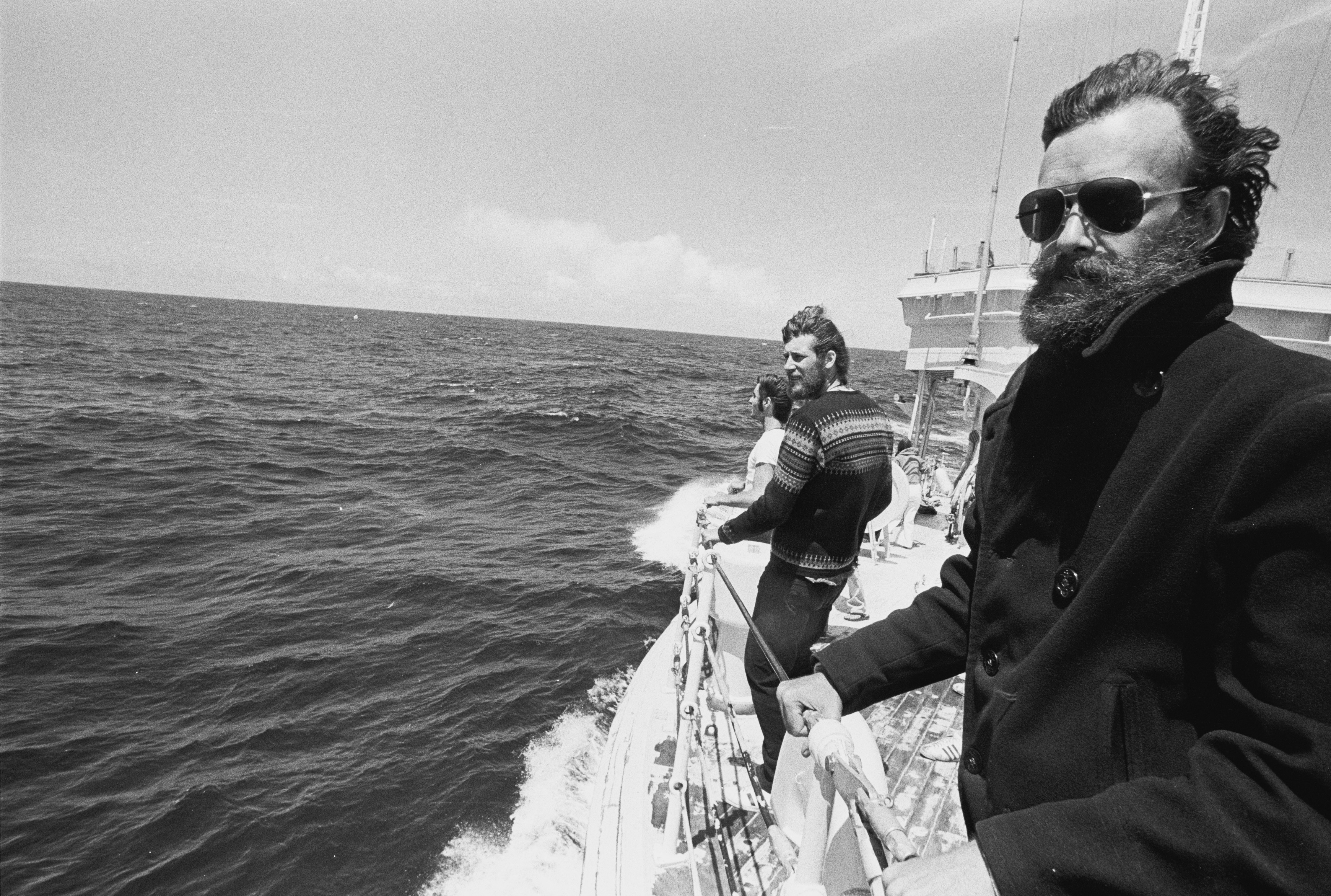
Bob Hunter on the deck of the James Bay; Rod Marining in the background; during the 1976 whale campaign. North Pacific, between Mexico and Hawaii, July 1976. © Greenpeace | Rex Weyler
Can you speak to Robert’s relationship with indigenous peoples of Canada, and of the world?
Bob had so many stories to tell about his experiences with the First Nations peoples, starting with being saved from freezing to death by a Huron elder during an ill prepared overnight camp adventure in his youth. He later became an honorary brother of the Kwakiutl nation of Alert Bay in B.C. during the voyage to stop nuclear testing at Amchitka Island on the first voyage with Greenpeace. This was a pivotal moment for Bob in his advocacy for First Nations rights. He would go on to write about their cause in his columns and later write two books that told of the history and the struggles of his brothers. The books were called “Occupied Canada” and “Red Blood.” He was a lifelong advocate for the rights of all Indigenous peoples globally.
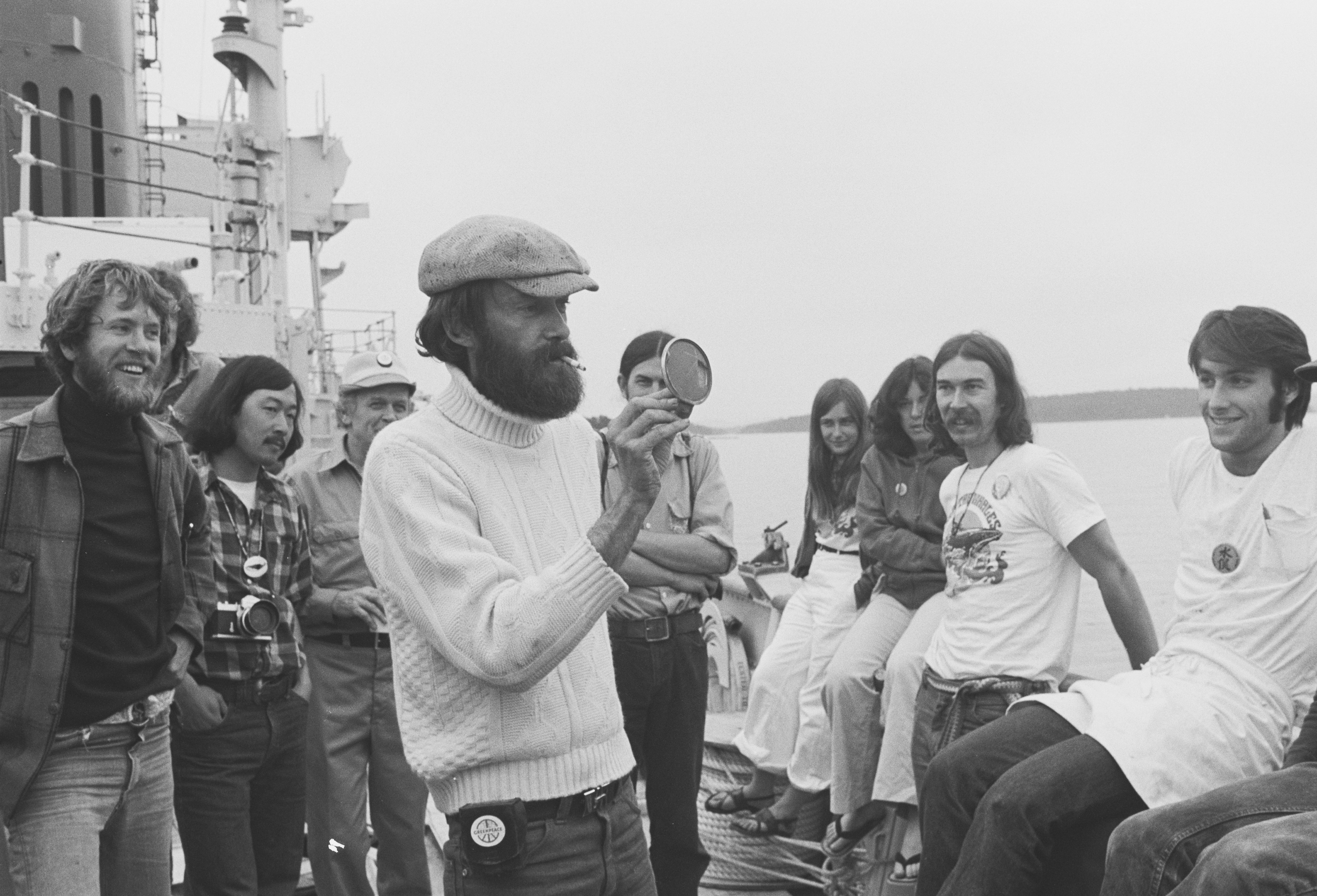
Bob Hunter talks with the James Bay crew at the beginning of the 1976 Soviet Whaling Tour to the North Pacific. Wickaninnish Bay, west coast of Canada, July 1976. © Greenpeace | Rex Weyler
What can Kinute’s readers take from this book as they strive to relate to the creep of climate change?
Back when Bob was with us, he thought that it was the end of times. He felt despondent and urgent at the same time about the impending climate crisis. Yet he found a way to make change. He became the “Master of the Mindbomb.” He read and read, he interacted with movers and shakers, and he wrote and wrote and wrote. He attended the Kyoto Summit. Soon after he wrote a well researched book on the crisis called “Thermageddon: Countdown to 2030.” Even though he felt alarmed at the degradation being inflicted on our planet and he was disconsolate at the pending Global Warming disaster we are facing he just never gave up. He was always looking for ways to enlighten people, educate and arouse. He was just one man, but he had a huge impact. You read about the personal impact he had on the over 40 authors in the book and if you read about the events and organizations that he helped to give life to you see a picture of a David in a Goliath world. He tried his best to make people realize that we are all capable of doing more. The ticket is, just do something from the heart.

Bob Hunter on the ship's radio with George Korotva, as the Phyllis Cormack approaches San Francisco after the 1975 whale campaign. North Pacific, Coast of California, July 1975. © Greenpeace | Rex Weyler
Is there anything else you would like to note to Kinute’s readers about this book?
Bob was a lifelong man of nature. He camped winter and summer in the wilds of Manitoba as a youth and young man. In his activism he was always face-to-face with the extremes of nature, be it out in the mid Pacific or standing on the ice flows of the north. We bought a boat and plied the B.C. west coast waterways in his mid years. Later when he moved to Toronto, he took up canoeing and he explored thousands of miles of northern Ontario and Manitoba River systems. He was never happier than when at one with nature.
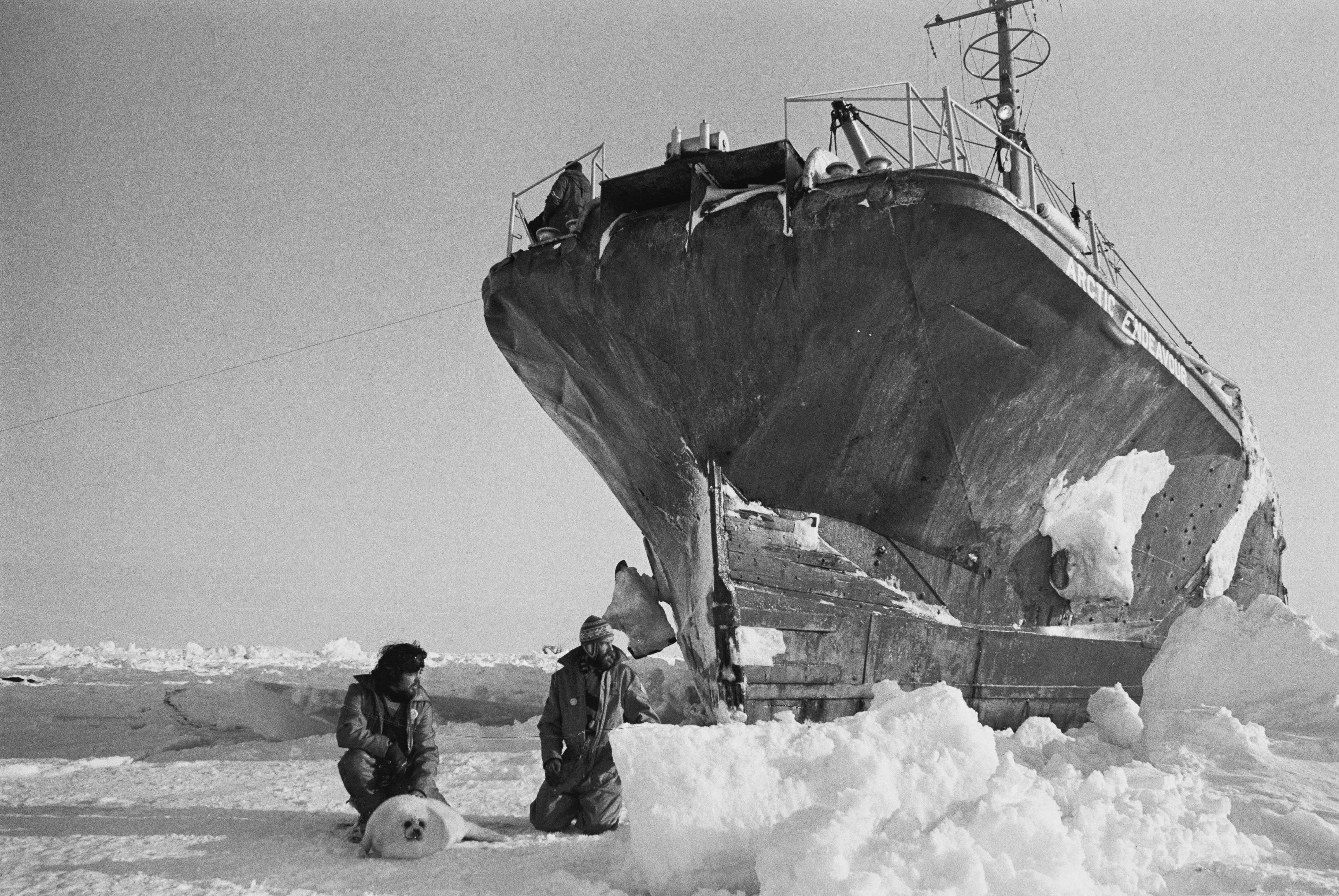
Greenpeace activists Paul Watson and Bob Hunter kneel down in front of a sealing ship to stop it from moving through the ice floes; an infant "whitecoat" Harp seal rests on the ice between them. Labrador ice floes, Canada, March 1976. © Greenpeace | Rex Weyler
Aptly so, there is a huge park named after him in the Rouge Valley Park system just northeast of Toronto. It is called Bob Hunter Memorial Park. It is befitting this crusader for the planet that this 400-acre plot of former corn fields is now a thriving ecosystem, with wetlands, new forests, trails for biking and walking, viewpoint and a meandering river running through it. Each year friends and family come to celebrate his life. Each year a new grandchild comes along. First River, then Rocket, then Phoenix and now Luna will share this nature experience and will continue to keep his genetic footprint alive. We are all blessed to be a part of his life.
There are exceptional people who we hear about in our lifetime, but most people don’t have the privilege of getting to know them. They are generally icons viewed from a distance. This book is about a very special human being. He touched the hearts and minds of so many people. Not just those people who knew him personally, but also his followers. Through his actions, his books, his newspaper columns and his media presence people listened and realized his angle on life was unique. It was a positive message of hope. Reaching him through those mediums combined with the human desire for a greater good, he was cherished and was close to many people he did not personally meet. It is my greatest hope that this book will reach more people and they too will be touched and inspired to do good for our fragile planet.
